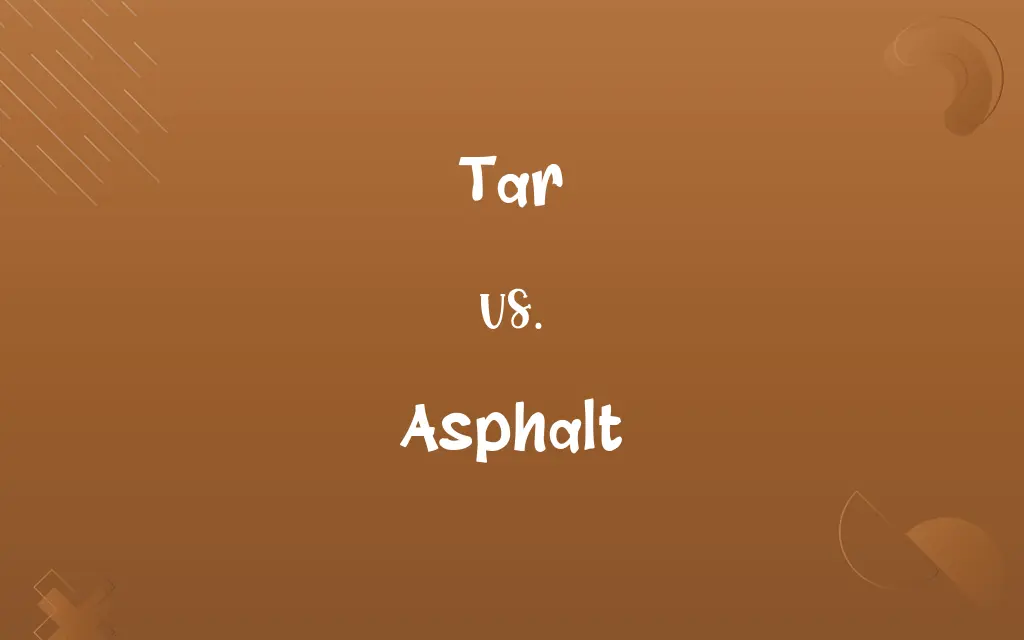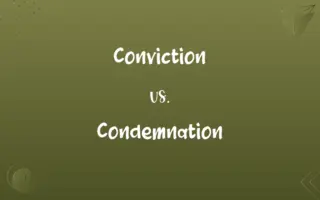Tar vs. Asphalt: Know the Difference

By Hifza Nasir & Dua Fatima || Published on November 1, 2024
Tar is a dark, viscous material obtained from the destructive distillation of organic matter, while asphalt, a mixture of bitumen and aggregates, is primarily used for road surfacing.

Key Differences
Tar is produced through the distillation of organic materials like coal, wood, or petroleum, resulting in a sticky substance used for waterproofing and sealing. Asphalt, on the other hand, combines bitumen (a form of tar) with aggregates like sand and gravel, creating a durable material for paving roads and driveways.
Dua Fatima
Nov 01, 2024
Tar has a broader application in industrial and preservation contexts, asphalt's composition makes it ideal for infrastructure, offering a smooth, durable surface that withstands heavy traffic. The production of tar involves heating at high temperatures to break down the original material, which can come from various sources. Asphalt’s production, conversely, is more uniform, typically involving petroleum bitumen mixed at high temperatures with its aggregates.
Hifza Nasir
Nov 01, 2024
Environmental considerations also differentiate them; tar can release volatile organic compounds (VOCs) during its application, posing health risks. Asphalt's environmental impact is largely due to the extraction and heating of petroleum, although recycling efforts have mitigated this.
Hifza Nasir
Nov 01, 2024
Asphalt roads require less frequent repairs than those treated with tar, as the latter is more susceptible to temperature fluctuations and weather conditions.
Dua Fatima
Nov 01, 2024
Comparison Chart
ADVERTISEMENT
Application
Waterproofing, sealing, industrial uses
Road surfacing, paving, driveways
Hifza Nasir
Nov 01, 2024
Production
Destructive distillation
Mixing bitumen with aggregates at high temperatures
Hifza Nasir
Nov 01, 2024
Environmental Impact
Releases VOCs, varies by source
Primarily from petroleum extraction, recyclable
Hifza Nasir
Nov 01, 2024
Durability
Sensitive to temperature, less durable
Resistant to heavy traffic, more durable
Shumaila Saeed
Nov 01, 2024
Tar and Asphalt Definitions
Tar
Used for coating and preserving.
The wooden boat was coated in tar to protect it from the water.
Hifza Nasir
Feb 29, 2024
ADVERTISEMENT
Asphalt
Primarily used in road construction.
Crews worked overnight laying asphalt for the highway.
Hifza Nasir
Feb 29, 2024
Tar
Has a natural basis, varying in composition.
Pine tar is used in traditional soap making.
Hifza Nasir
Feb 29, 2024
Asphalt
A mixture used for paving surfaces.
The new road was smooth with fresh asphalt.
Hifza Nasir
Feb 29, 2024
Tar
Can be derived from coal, wood, or petroleum.
Coal tar is a byproduct of coke production.
Shumaila Saeed
Feb 29, 2024
Asphalt
Known for its recyclability.
Recycled asphalt reduces the need for new materials in road repair.
Hifza Nasir
Feb 29, 2024
ADVERTISEMENT
Tar
Applied in industrial and marine contexts.
Tar was traditionally used to seal the joints of wooden ships.
Dua Fatima
Feb 29, 2024
Asphalt
Offers a smooth, durable finish.
Asphalt driveways are popular for their longevity and low maintenance.
Dua Fatima
Feb 29, 2024
Tar
A thick, dark liquid obtained by distilling organic material.
The smell of tar filled the air as workers waterproofed the roof.
Dua Fatima
Feb 29, 2024
Asphalt
Comprises bitumen and aggregates.
Asphalt's durability comes from its carefully measured components.
Dua Fatima
Feb 29, 2024
Tar
A dark, oily, viscous material, consisting mainly of hydrocarbons, produced by the destructive distillation of organic substances such as wood, coal, or peat.
Hifza Nasir
Feb 28, 2024
Asphalt
A mixture of bitumen with crushed stone gravel or sand, used for paving or roofing.
Hifza Nasir
Feb 28, 2024
Asphalt
A sticky, black and highly viscous liquid or semi-solid, composed almost entirely of bitumen, that is present in most crude petroleums and in some natural deposits.
Hifza Nasir
Feb 28, 2024
Asphalt
Ellipsis of asphalt concrete, a hard ground covering used for roads and walkways.
Hifza Nasir
Feb 28, 2024
Tar
A black, oily, sticky, viscous substance, consisting mainly of hydrocarbons derived from organic materials such as wood, peat, or coal.
Hifza Nasir
Feb 28, 2024
Asphalt
A dark bituminous substance found in natural beds and as residue from petroleum distillation; consists mainly of hydrocarbons
Hifza Nasir
Feb 28, 2024
Repeatedly Asked Queries
Why is asphalt preferred for roads?
Its mixture with aggregates provides a durable surface capable of withstanding heavy traffic and less frequent repairs.
Dua Fatima
Nov 01, 2024
How is asphalt produced?
Asphalt is produced by mixing petroleum bitumen with aggregates like sand and gravel at high temperatures.
Hifza Nasir
Nov 01, 2024
What are the environmental impacts of using tar and asphalt?
Tar can release harmful VOCs, whereas asphalt's impact comes from petroleum extraction; however, asphalt is recyclable.
Hifza Nasir
Nov 01, 2024
Is asphalt environmentally friendly?
Asphalt is considered more environmentally friendly than tar due to its recyclability.
Hifza Nasir
Nov 01, 2024
Are there any health risks associated with tar?
Yes, the application of tar can release VOCs, posing potential health risks.
Dua Fatima
Nov 01, 2024
Can both tar and asphalt be recycled?
Asphalt is more commonly recycled due to its composition, reducing the need for new petroleum bitumen.
Hifza Nasir
Nov 01, 2024
Can tar and asphalt be used interchangeably?
While both are used for paving, their composition and applications differ, making them suitable for specific uses.
Hifza Nasir
Nov 01, 2024
What makes tar and asphalt different in terms of application?
Tar's application spans waterproofing and industrial uses, while asphalt is specifically formulated for paving and road surfaces.
Dua Fatima
Nov 01, 2024
What is tar made from?
Tar is made from the distillation of organic materials such as coal, wood, or petroleum.
Dua Fatima
Nov 01, 2024
How does the durability of tar compare to asphalt?
Tar is more sensitive to temperature changes, making it less durable than asphalt for paving purposes.
Shumaila Saeed
Nov 01, 2024
How does weather affect tar and asphalt?
Tar is more susceptible to weather conditions, while asphalt offers better resistance to temperature fluctuations.
Hifza Nasir
Nov 01, 2024
What types of aggregate are used in asphalt?
Sand, gravel, and crushed stone are common aggregates mixed with bitumen to make asphalt.
Dua Fatima
Nov 01, 2024
What are the main uses of tar?
Tar is used for waterproofing, sealing, and in various industrial applications.
Dua Fatima
Nov 01, 2024
Why is tar used in roofing?
Its waterproofing qualities make tar ideal for sealing and protecting roofs.
Hifza Nasir
Nov 01, 2024
How often do asphalt surfaces need to be replaced?
With proper maintenance, asphalt surfaces can last for decades before needing replacement.
Hifza Nasir
Nov 01, 2024
Share this page
Link for your blog / website
HTML
Link to share via messenger
About Author
Written by
Hifza NasirCo-written by
Dua Fatima







































































